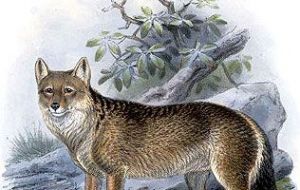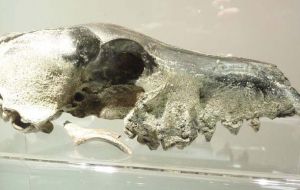MercoPress. South Atlantic News Agency
Falkland Islands wolf-like canine Warrah pre-dates human occupation
 The Warrah puzzled Charles Darwin when he visited the Falkland Islands in 1837
The Warrah puzzled Charles Darwin when he visited the Falkland Islands in 1837 Bones found on West Falkland in 2010 by a boy then aged thirteen, which were subsequently kept for a while in the bottom of his grandmother’s wardrobe, may have narrowed down the search for an answer to a mystery which puzzled Charles Darwin when he visited the Falkland Islands in 1837.
The bones, parts of three separate skulls, which were discovered on his parents’ farm by young Dale Evans, have been identified as belonging to the Warrah (Dusicyon antarcticus-australis) a wolf-like canine which once inhabited the Islands in great numbers but became extinct when the last one was shot in 1876.
Some stuffed examples of the animal survive in a few European museums, together with some skulls and other bones. These museum specimens show clearly that the Warrah was significantly different from any animal found in South America, but fail to answer the question about its origin posed by Darwin and by countless others since, because they belonged to animals that had been killed in the 19th Century.
Dale Evans’ find is remarkable because the bones he found in a dried up pond are the only ones in existence that belong to animals that apparently died naturally. Even more remarkable, carbon dating carried out in a leading forensic laboratory in the United States, places the one fragment from which a reading could be obtained at 1,000 years old.
The extermination of the Warrah, which was seen as posing a threat to the newly introduced sheep on the Falklands, was easy due to the animal’s apparent total lack of fear of humans. Charles Darwin reported that the gauchos with whom he made some excursions around the Islands told him that they would kill Warrahs by holding a piece of meat in one hand to attract the animal and a knife in the other with which to kill it.
There have been countless theories about how the Warrah arrived in the Falklands. Their readiness to approach man led to a common belief that this animal, the only endemic quadruped in the Falklands, might be descended from the semi-domesticated dogs belonging to the Yahgan indians who lived on the coast of the South American continent over three hundred miles away and might have been brought to the Islands in their canoes, though there is no concrete evidence of this ever happening. Other theories suggest their arrival on floating vegetation or maybe ice floes, though the lack of a similar animal on the mainland from which they are supposed to have come does tend to weaken these arguments.
While questions about the Warrah’s origin still remain, Dale Evans’ find and the subsequent discovery that the animal was present on the Falkland Islands at least seven centuries before the recorded arrival of man, does narrow down the historical focus considerably.
By SeAledPR - Stanley





Top Comments
Disclaimer & comment rules-

-

-

Read all commentsSurprised at this story, the origins of the Warrah were revealed in 2009,
Jun 01st, 2011 - 08:12 pm 0Traditionally it had been supposed that the most closely related genus was Lycalopex, including the Culpeo (and its domesticated form, the perro Yaghan), which has been introduced to the Falkland Islands in modern times. However, in 2009, research conducted by a scientific team directed by Graham J. Slater at the University of California, Los Angeles, identified the Falkland Island wolf's closest living relative as the Maned Wolf (Chrysocyon brachyurus) - an unusually long-legged, fox-like South American canid, from which it separated about 6.7 million years ago.[3]
From http://en.wikipedia.org/wiki/Warrah
That's not a skull that's just a piece of skull. Al final estos están más agrandados que bombacha de gorda.
Jun 01st, 2011 - 08:31 pm 0pre-dates human occupation
Jun 01st, 2011 - 08:32 pm 0just as well, if the humans were their, then they would have killid it,
humans are not that good at preserving things, untill they are thousands of years old, , but interestingly,
as the falklands are an island 300 miles from land, how did they get there ? were they south american in origin ??
Commenting for this story is now closed.
If you have a Facebook account, become a fan and comment on our Facebook Page!